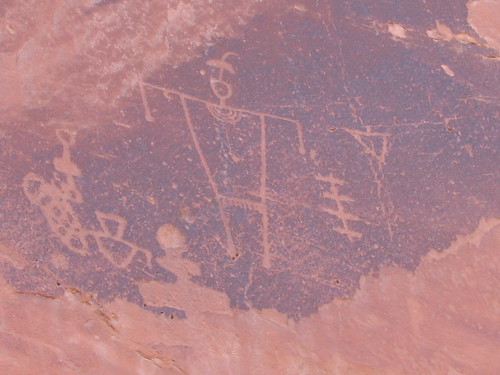It is indeed true…I do not write at all, my not writing is taking on dimensions.
– Rainer Maria Rilke
April 19, I’ll be floating down the San Juan River in Utah with a group of high school students. It will be my third rafting trip in as many years. I can’t wait.
Last year’s trip took us down a stretch of the Colorado River. Returning to the San Juan means calmer waters and a chance to see some amazing petroglyphs.
I remember standing, staring at them two years ago.
Our river guides were explaining their pre-historic origins and importance as sacred relics to the native peoples of the areas.
“What do they mean?” I kept asking.
As seasoned as our guides were, they admitted we could never know, but only guess at the stories being depicted.
As a collector of stories, this saddened me.
One of my G11 students, Luna, IMed me this afternoon to share something she’s been working on as part of the Stones project my kids are collaborating on right now.
It frightened me.
My formal training and experience is in the realm of reading and telling stories linearly. I’m not talking analog versus digital. My training, the stories I’ve been told work along line from beginning to end.
What Luna created starts to push against that.
It spiraled and flowed and moved. Readers can choose where they enter the text and in what direction they move from there. It has an order and sense to it, but those elements can be freely ignored.
I’ve never taught her that. I’ve not taught any of my students that.
I rally against digital storytelling for the simple reason it shifts the focus from the story to the medium.
I’ll continue to do so.
Digital storytelling, at least what I’ve seen, asks keeps the standard structure, adding images and sounds.
The Anasazi, Ute, Navajo and their archaic pre-cursors understood the implications of telling a story in pictures centuries before VoiceThread or Prezi came on the scene.
In fact, they did it better. Watch most digital stories online and consider how closely they are influenced by standard narrative structure. They remain beholden.
Stare at an ancient petroglyph, though, and realize there are ways to tell and read stories that have been lost to us. That loss opens the door to their re-creation.
I’m uncertain how to do that.
I worry I don’t do enough to help my students see words, language, reading, and writing as more than just skills, but to help them see those things as art as well.
Arts programs around the nation are being reduced or cut. Unofficially, it is because they are untested subjects. I’m fortunate to work in a subject whose survival is protected by standardized testing. Unfortunately, that protection also threatens its existence as an art.
I don’t know if the tools exist to help my students tell stories outside a traditional linear narrative. As a standard point of entry, PowerPoint does much of the early work of reinforcing the idea the tales we tell must move along a thread (voice or otherwise).
I’m unsure how to prepare my students to balance the traditional linear intake and creation of stories while giving them room to play with the ideas that because this is the way they’ve always experienced stories, doesn’t mean they can’t find a better way.
I don’t know how to teach myself that either.
I do know we can teach stories better.

I live in Colorado. I have explored and hiked in Colorado,, Utah, new Mexico, Arizona; I have seen many petroglyphs. Did you ever wonder if it may have been grafitti done by teens and the youth of the times? If so does this change the meaning? Were the adults telling them to quit writing on the walls because it was unattractive? Did we lose the stories of the youth of the Anasazi because adults of the time ,”cleaned the grafitti from the walls.”?Just wondering…what do your students think?Linda Conway
It's crazy how excited I get by every little shift in this story. Every little add-on or new development feels like a shift in the tale, and maybe that is what is happening. We are all telling a story, each of us across the web. Each change or new idea advances the plot in some way. Maybe we will not know what the story is about until it has been written for a bit longer. I think it is comfortable to stay linear and tell tales as we are used to them, but it is exciting to see where they could go.